Last week I covered this 1972 Chevrolet Corvette LT-1. Its most notable feature is its LT-1 engine, but the ‘Vette wasn’t the only benefactor of this excellent powerplant in ’72, the Z28 Camaro got in on the act too. For your review today, we have a 1972 Chevrolet Camaro Z28 with a claimed 35K miles! Is that possible, and authentic? Let’s look further and see what we can determine. This high-winding hot-rod is located in Angola, Indiana and is available, here on craigslist for $49,995. A tip of the hat goes to Pat L. for this discovery!
Besides the odometer reading, the mileage claim is based on a September 2021 Certificate for Title from the state of Indiana. The seller adds, “Actual on the title, not exempt. Clear Indiana title issued in 2021 after odometer verification“. I have run into instances where Motor Vehicle Administrations exempt mileage recordings from five-digit odometers but perhaps that’s not the case here. The seller claims that only 2,575 Z28s were assembled in ’72 and further research supports that claim – this isn’t a common car.
As with the LT-1 Corvette, this Camaro’s strength is its 255 net HP, solid-lifter 350 CI V8 engine. Interestingly, this one has been completely apart for a rebuild, something not expected. The underside of the motor is too clean for a 50-year-old engine with 36K miles – I know from experience that Chevy engines, both small and big blocks, have a tendency to weep and this one is just too clean (the missing bell housing inspection plate will be reattached). There are several other improvements/changes that have been applied to the engine and the seller goes into pretty deep detail. Rounding out the drive train is a Muncie close-ratio four-speed manual transmission spinning a 4.10:1 rear gear – the 4.10s were an option in ’72. With all the goodness that has been bestowed on this top dog Camaro, there is nary a word as to how it motivates – well, I imagine. One minor observation, 1972 Chevrolet engines no longer placed a displacement/horsepower decal on the air cleaner, that feature ended with the ’71 models.
The exterior’s Cranberry Red looks probably as it did in ’72. The seller claims inside storage has been the key to this car’s preservation and that’s no surprise, it presents too well for any other situation. The exterior images aren’t the best, they’re too dark with too many shadows but nothing looks out of place or problematic. The first four years of these second-gen Camaros (’70-’73) are the best IMHO – it’s just a perfect balance. And the Z28, in this case, isn’t shy or retiring but it’s not as cartoonish as the ’74 with the massive hood decal telling everyone what they already knew, “Yes, it’s a Z28“, or the bulbous and plastically looking ’78-’81 vintage.
The black vinyl interior appears to be in sound condition and supports this car’s limited use. I owned a ’77 Z28 that had a black vinyl austere interior and was really no different than what’s here. It’s functional, no doubt, but maybe not as refined as what one would find in a similar era Trans Am. The only non-original item spied is the gear shift’s T-handle. The seller adds, “FACTORY KEY BUZZER STILL WORKS, FACTORY RADIO STILL WORKS, HORN WORKS“.
Well, this Camaro seems original and genuine and that LT-1 engine sets this Z28 apart from its L82-powered ’73 successor – this is definitely a more collectible specimen. Regardless, an up close and in-person inspection would be warranted, especially at this price point. Assuming that it checks out (I still wonder about the reason for the low mileage engine rebuild – sitting too long maybe?), this Z28 is a heck of a find, wouldn’t you agree?
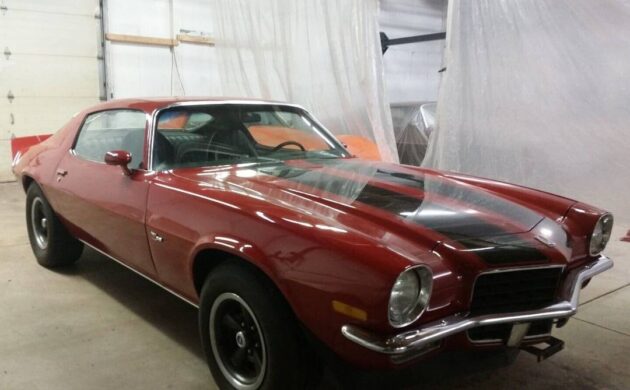

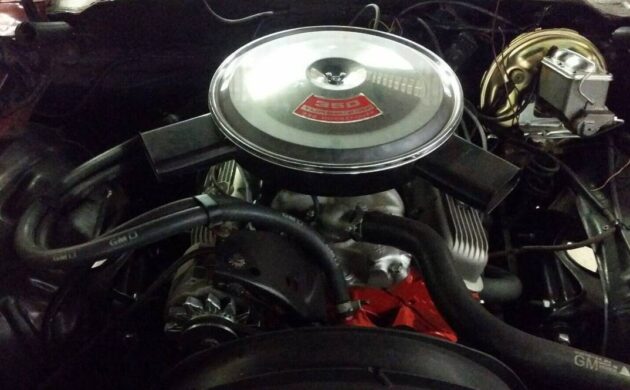
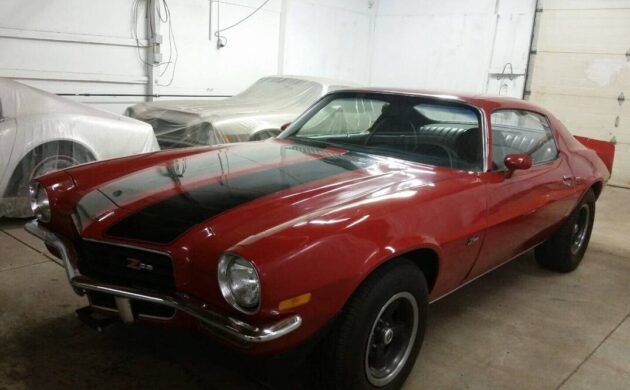
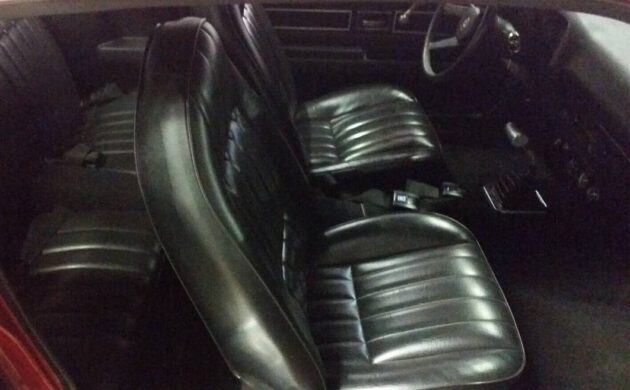
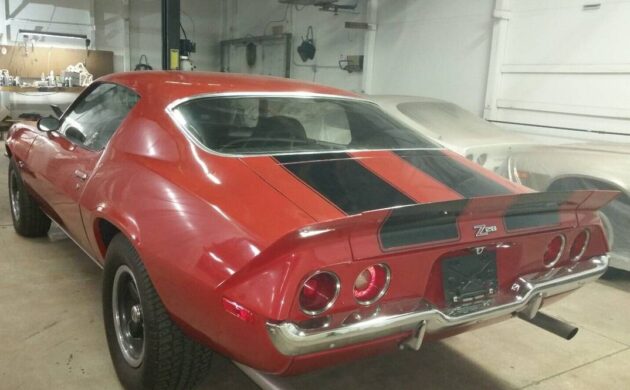


Beautiful car with a hefty price. Probably would bring more than that at a Mecum auction.
This car is for sale on ebay:
https://www.ebay.com/itm/295472262215?hash=item44cb84ec47:g:KNEAAOSwtZljwswr&amdata=enc%3AAQAHAAAAoAAN%2BKLcOwm%2FfXrbicNZBhWydGou%2FEb4a3Ge7M8BAXwXze28pJZuEGPp5JQxPGIJPybGShfubSQ5amrLcowZ4lsBoBDZti9IB3Fhjs4fyxxOxh%2FTNLsBjoGNERcet64CISuWpbYI9uh%2FavRLLsFYwRnXk9C6WKIt4ixsn7%2FI3VIME9oOGZA5YCl7TTlWjD%2FsuOYijyuexgtW3s2%2BORO1kNo%3D%7Ctkp%3ABk9SR67grLC3YQ
Second generation Z cars are finally getting respect. Far superior to 67 to 69. I have driven several, both Classic Copper Metallic with white stripes and 4 speed. Best GM small block ever. This car is a gem and the last solid lifter Camaro built. But with that 4.10 rear, bad on gas and plenty of noise.
Sweet.
Nice 72. Fear the Gear.
Seems to be a fair asking price for a real rare Z car with super low miles.Need to see some underbody pics to be sure of any Indiana salt issues.
There are underbody photos. Barnfinds just did not put them up. The floors are very nice in this car. It has had only two private owners since new and was kept inside and cared for!
Beautiful car. Nice write up. For the that money though, I would comparison shop with a 1970 SS 350 Camaro. You can have 300 hp at your disposal for about the same money.
The motor in this Camaro was way underrated and would blow the doors off of a 70 SS350 Camaro. The only good thing with the 70 Camaro SS or Z/28 was that they put 12 bolt axles in them but that was the only year for that strong part.
This year was rated 245 hp I had one almost new . Compare to the late sixties and up to 1970 this thing would’ve not fallen out of a tree. Weak and ran out of power range early not a high RPM engine. I know because I was there not listening to others fantasies. These were the same as corvette but rated almost the worst corvette engine ever except it was even 74 through 78 or. So . Corvette and Z cars were rated 165 H p . No super car here
Nope, it was 255 net HP, brochure attached.
The ’73 and ’74 L82 equipped Z28s were rated at 245 net HP.
JO
John:
Thx! The difference is that the ’70 had 300 gross HP, this Z has 255 net HP which is probably 325 to 330 gross HP. Gross to net ratings occurred in ’72, while ’71 displayed both.
JO
Ahhh! You’re right, of course. I forgot about my grosses and nets. But I still love my ‘70 SS 350.
These 72 LT1 Z28 motors will make over 400hp on our dyno with very little changes, especially with the 1970 LT1 dome pistons installed. They were underrated. They were more powerful then the 1969 Z28 engine and we have made over 580hp even with the 302 DZ and MO engines with only cam change and head porting and offset grind on the crank from 3.000 to 3.250. The LT1 350 1970-1972 is more than most think. Do not let GMs underatings for insurance purposes fool you. Zora Arkus-Duntov Chevrolet’s director of competition at that time called this motor “The Little Mouse That Roared”! The 1972 still came with same high lift 242/254 duration @ .050 camshaft, same 780 cfm Holley, and same high flow big valve heads as the 1970 and the Winters GM aluminum high rise intake. It was improved engine over the 1969 Z28 more stroke on the crank and spin in rocker studs and guide plates to keep the rocker studs from pulling out. The 1969 Z28 and 1970 Z28 used the same #186 double hump head but with spin-in studs and plates. The 1972 used the 487 casting. Same big valve head but larger chamber. Same high flow port. Compression ratio was the only real change from 1967 z28 to the 1971 and 1972. And, the LT1 had improvements over the 1969 Z 28 302 DZ. This one behaves more like a 1970 LT1 and dare I say better??
Many people do not realize this but the 1972 Z28 has a higher Hagerty book value then the 1970 Z28. Likely due to such low production. Also,this particular car while retaining the correct block, heads, intake etc for 1972 has had the GM forged flat top pistons removed and now has a set of standard bore genuine 1970 Z28 dome pistons GM part number 3959456 installed with a fresh torque plate hone and new moly rings. A third ultra fine Sunnen JHU818 hone stone was used for that extra competition cylinder wall finish. So, it runs better than you might suspect. Also, it had a comp valve job on a $20,000 + Sunnen VGS 20 head machine and stainless swirl polished 2.20 /2.600 valves when the pistons were changed a more reliable true double roller chain and gear set.
That was 2022 Hagerty book value. I see Hagerty now did raise the 1970 z28 slightly higher for 2023. In my opinion, a mistake.
Sorry to say I’m confused. I was under the impression that solid lifter lifter 11 to 1 compression LT 1 engines ended in 1970 or perhaps 71 due to federal regulations.
Is all this discussion regarding the LT1 option referring to GM marketing of power steering or an Actual LT 1 engine with 11 to 1 compression and solid lifters.
Any help would be appreciated. Thanks
The solid lifter LT-1 was made three years:
’70 360 gross HP in the Z28 and 370 gross in the ‘Vette (comp. ratio – 11:1)
’71 330 gross in the ‘Vette and Z28 (comp. ratio – 9:1)
’72 255 net HP in both cars (comp. ratio – 9:1)
JO
Thank you Jim,
I thought something had to be different from the 1970 high compression, high cam lift, solid lifter engines.
With lower compression, did they also get rid of the four bolt main block, and good rods and pistons?
I do not mean to waste your or anyones time, I just need to be careful paying for an LT1 engine that is not truly an LT1.
With that in mind, if I wanted a true LT1 engine in a 72 camaro, I may be fiscally better off cloning a sold rust free camaro into a Z28 using better parts than stock offerings.
Thank you
Dan:
The internals are the same, forged components and four-bolt main bearing caps. The biggest difference is the reduction in the compression ratio on the ’71 and ’72.
JO
Cool car, but I question the mileage. Looking at the pictures, it has been restored, and it looks like a frame off restoration as everything on it is too clean and new looking. Its not original as it has headers on it. Don’t know if that helps or hurts the value. Wrong shifter, probably works better than stock, but does it help or hurt? Was it originally a Z28? Did it have an AIR pump that year? The price is cheaper than what it would cost you to make it this nice, so its a deal on that regard. Cool car and if got it, I would outsource the missing period correct parts and really increase its value. Good luck to the next owner. I am not hating, and am a bit jealous at I love this body style.
Most hobbyists will give headers a pass. People that insist on cast iron exhaust manifolds and air injection pumps are in a whole other category.
That they are! I own a 68 restomod Vette. The amount of questions as to why I did something different is beyond me. But this Camaro seems pretty close to stock.
The good internals were put in the Z/28 thru the 72 model year other then the 11 to one pistons.73 saw the use of a hydraulic lifter cam and air condition as a option on the Camaro.Strange but the 72 Corvette LT1 had air as a option and might be the only solid lifter engine to ever have it from Chevrolet.
Totally awesome car…and I don’t even like Chevys. I’d bet this is a screamer.
What a nice ride. Then I saw Angola! Glad its Angola, IN and not Africa!
Actually, Pontiac made even less t/a’s in ’72 – only 1286!
With it’s 455 HO & very long stroke, it might even be faster than the ’72 z28, even with 3:08 rear, & even lower compression. But it did not have all the goodies inside its motor that the Chevy did. But it could be driven at high speeds on expressways with those big cubes.
https://www.hemmings.com/stories/article/ho-ho-ho-1972-pontiac-trans-am
A 396 camaro might keep up, however – still, the 454 should also have been offered in the camaro – to compete with the bird.
There was nothing that was american made that could beet a Pontiac all the way thru to the 79 model year. Then 10 years later Pontiac did it again with the Turbo Trans am.
I know this car well. The engine was refubished to replace dried out valve stem seals, brittle old piston rings, dried out gaskets and seals and what many people will like is that standard bore GM part numbered dome pistons part number 3959456 were installed in the 4-bolt block at the time of engine refubishment. This are the same pistons that GM used in 1970 Z28. Also, the mileage is actual. Also, the M21 close ratio transmission received also new seals and gaskets and even a new tail shaft bushing! My understanding of the car is the original owner ordered if with 4.10 rear gear for stock class racing NHRA. Indiana will not allow “actual mileage” classification unless title history and owner history carefully show the mileage is correct. The car was only used for NHRA racing for some time and then put up. Also, only minimal changes were made to the car for NHRA such as scatter bell housing, drive shaft loop, different exhaust, a hotter igition coil, and a different faster shifting hurst shifter. There are photos posted of the undercarriage. The floors in the car are extremely nice and rust free! The back seat and insides of the quarter panels still retain GM factory spatter paint. The quarters still have the GM stamps. I was forunate to find this car as it was under the radar for many years and is a very special low mile example–very few with this mileage remain.
GM plant in Norwood went on strike in 72. That’s why so few were built. Really sad part was all the Camaros on the line when it stopped, we’re scrapped when the strike was over. 73 MY were different and not cost effective to update the 72’s.
I find it very hard to believe that they HAD to SCRAP the unfinished ’72 camaros, since all they would have had to do was unbolt the
’72 front(& rear?) bumpers & brackets & bolt on the ’73s.
Same with the firebirds.
& maybe swap out carbs.
Maybe a problem tho with ’72 RSs & the front center section, but IMO only the ’72 RS’s should have been scrapped – or converted to ’73 non RSs!
& all the unused ’72 bumpers & brackets & carbs could have been sold over the counter!!
Big mistake, IMO.
I could see if the the strike was in ’73 & having to scrap THOSE unfinished ones, since the ’74s had totally new front & rear ends.
The crushing video …
https://www.youtube.com/watch?v=cXqrz-8ns2c
Find a copy of the book ECHOES OF NORWOOD. U ll understand what I m texting about
Some of those ’72s were not scrapped. Quite a few were finished and donated to technical schools throughout the country for use in mechanics classes. One surfaced about three years ago that had been at a Louisiana Tech School for 30+ years. It was a base model 307 if memory serves, and the owner obtained it after the school closed. It was a relatively low mileage car that had an engine that was taken apart who-knows-how-many-times over the years and reassembled. Very good shape too. I remember inquiring about it, but it was a little too plain jane for me, even though it had a cool history.
I would think the 4 speed ’69 Blue Maxi “z29” Camaro with the prototype ’70 z28 motor would be faster & worth a lot more money than a regular 302 ’69 z28 & certainly any 350 2nd gen z28 …
https://www.caranddriver.com/reviews/a15141483/chevrolet-blue-maxi-camaro-z-29-archived-test-review/
The car still exists.
Joe, great article. Wow, Mark Donohue himself was involved with that Blue Maxi. Yes, they chose the LT1 over the 302 DZ. The 1970-1972 LT1 was an upgrade for not only power but reliability in valve train over the 1969 Z28 engine!